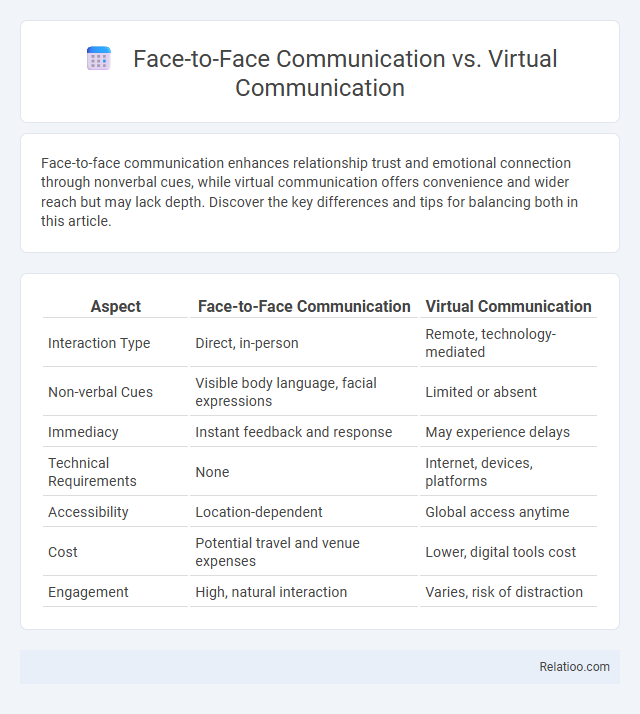Face-to-face communication enhances relationship trust and emotional connection through nonverbal cues, while virtual communication offers convenience and wider reach but may lack depth. Discover the key differences and tips for balancing both in this article.
Table of Comparison
| Aspect | Face-to-Face Communication | Virtual Communication |
|---|---|---|
| Interaction Type | Direct, in-person | Remote, technology-mediated |
| Non-verbal Cues | Visible body language, facial expressions | Limited or absent |
| Immediacy | Instant feedback and response | May experience delays |
| Technical Requirements | None | Internet, devices, platforms |
| Accessibility | Location-dependent | Global access anytime |
| Cost | Potential travel and venue expenses | Lower, digital tools cost |
| Engagement | High, natural interaction | Varies, risk of distraction |
Introduction to Face-to-Face and Virtual Communication
Face-to-face communication offers rich, non-verbal cues such as facial expressions and body language that enhance understanding and trust-building. Virtual communication relies on digital tools like video calls and messaging platforms, which can limit emotional nuance but increase accessibility and convenience. Your ability to effectively navigate both communication types is essential for fostering trust and collaboration in diverse settings.
Key Differences Between Face-to-Face and Virtual Communication
Face-to-face communication allows for immediate feedback through body language and facial expressions, fostering a stronger emotional connection and trust-building compared to virtual communication, which often lacks these non-verbal cues. Your ability to establish trust is influenced by the richness of in-person interactions, where tone, eye contact, and physical presence enhance understanding and rapport. Virtual communication relies heavily on verbal and written cues, which can lead to misunderstandings and slower trust development due to limited context and delayed responses.
Advantages of Face-to-Face Communication
Face-to-face communication enables immediate feedback and richer nonverbal cues such as body language and facial expressions, which significantly enhance trust-building between participants. This mode of interaction fosters stronger interpersonal connections and reduces misunderstandings, creating a more authentic and engaging environment. Compared to virtual communication, face-to-face encounters encourage deeper emotional bonds and collaboration, critical for successful teamwork and relationship development.
Advantages of Virtual Communication
Virtual communication offers unparalleled flexibility, allowing you to connect with colleagues and clients across different time zones without the constraints of physical presence. It facilitates real-time information sharing through digital tools, enhancing efficiency and documentation accuracy. This mode of communication can also support trust-building by fostering consistent interactions, enabling transparency through recorded conversations, and providing diverse channels to express ideas and feedback effectively.
Nonverbal Cues: In-Person vs. Online Interactions
Nonverbal cues play a crucial role in trust-building, with face-to-face communication offering richer signals such as facial expressions, body language, and eye contact that enhance understanding and emotional connection. Virtual communication often limits these cues, relying on tone of voice and limited visual feedback, which can create challenges in accurately interpreting intent and building trust. To strengthen your online interactions, consciously enhancing verbal clarity and using video calls can help compensate for the reduced nonverbal communication compared to in-person meetings.
Impact on Relationship Building and Team Dynamics
Face-to-face communication enhances trust-building through nonverbal cues, fostering stronger relationships and more cohesive team dynamics. Virtual communication, while offering flexibility and broader reach, often challenges trust development due to reduced physical presence and limited emotional expressiveness. Effective relationship building in virtual teams requires intentional communication strategies and trust-building practices to overcome these barriers and maintain team collaboration.
Communication Barriers in Virtual and Physical Settings
Face-to-face communication facilitates immediate feedback and nonverbal cues, reducing misunderstandings that often hinder trust-building. Virtual communication faces barriers such as technological glitches, lack of physical presence, and delayed responses, which challenge emotional connection and trust development. Both settings require intentional effort to overcome these obstacles for effective trust-building, with face-to-face settings benefiting from richer contextual cues and virtual environments relying on clear, consistent messaging.
Productivity and Efficiency in Different Communication Modes
Face-to-face communication fosters higher trust-building through non-verbal cues, enhancing productivity and efficiency by reducing misunderstandings and speeding decision-making. Virtual communication offers flexibility and quick information sharing but may hinder trust development, potentially lowering collaboration effectiveness and slowing project progress. Your choice of communication mode directly impacts team dynamics, influencing overall output and organizational success.
Choosing the Right Communication Method for Your Needs
Face-to-face communication fosters trust-building through nonverbal cues and immediate feedback, making it ideal for sensitive or complex discussions requiring strong interpersonal connections. Virtual communication offers convenience and accessibility, enabling collaboration across distances but may require deliberate efforts to maintain trust via consistent and transparent interactions. Selecting the right communication method depends on factors like urgency, relationship depth, and the need for emotional nuance to effectively build and sustain trust.
Future Trends in Communication: Blending Physical and Virtual Worlds
Future trends in communication emphasize the integration of face-to-face and virtual communication to enhance trust-building by leveraging immersive technologies like augmented reality (AR) and virtual reality (VR). Blending physical and virtual worlds creates richer interactions, allowing non-verbal cues and real-time feedback to foster deeper relational bonds despite geographical separations. Organizations investing in hybrid communication platforms are poised to optimize collaboration efficiency and trust development in increasingly distributed work environments.

Infographic: Face-to-Face Communication vs Virtual Communication
 relatioo.com
relatioo.com